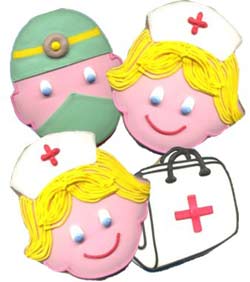From puberty to menopause, menstruation is a significant part of a woman’s life. Why does menstrual blood occur? Why does menstrual pain happen? This natural phenomenon is something every woman should understand.
How much blood is lost during menstruation?
 |
(Image: Cookiepots) |
Menstrual blood flows from the uterus due to the shedding of the endometrial lining, and the amount of menstrual blood varies among women and from month to month, ranging from 5ml to 25ml.
What causes menstrual blood? The blood comes from the endometrium, or more precisely, the periodic shedding of the superficial layer of the endometrium, which results from hormonal changes that occur at the end of the menstrual cycle.
Each menstrual cycle can be divided into four stages. The first stage is called the follicular phase. During this stage, estrogen hormones are secreted in increasing amounts; these hormones cause the endometrial lining to thicken and increase the number of blood vessels. During this time, an egg matures in the ovaries and is released. This stage is known as ovulation; the egg travels through the fallopian tube toward the uterus, which has undergone changes to prepare for the egg. Once the egg is released, the level of estrogen in the female body begins to gradually decrease.
The third stage is known as the luteal phase or the progesterone secretion phase; it is characterized by the corpus luteum (the remnant of the follicle after the egg has been released) secreting another hormone called progesterone. This hormone prepares the uterus for the implantation of the fertilized egg (if the egg has been fertilized by sperm). To support the implantation of the egg, the uterus must engorge with blood, develop tissue, and contain sufficient sugars and proteins. However, if fertilization does not occur during the days that the egg travels through the fallopian tube, the level of progesterone begins to decrease. Eventually, the unfertilized egg will disintegrate, and the thickened endometrial lining will shed. The expelled material is referred to as menstrual blood, which exits through the cervix and vagina. Therefore, the fourth stage is menstruation.
How long after ovulation does menstruation occur? The first day of menstruation corresponds to the first day of the menstrual cycle. The last day of the cycle is the day before the next cycle begins. Regardless of the number of days between two cycles, menstruation will occur 14 days after ovulation. Conversely, the period before ovulation is not fixed.
What is the frequency of the menstrual cycle and how long does each menstruation last? Every woman experiences unique menstrual cycles. The cycle can vary from 20 to 40 days (more than 45 days is termed oligomenorrhea). Most women have cycles ranging from 26 to 34 days, and approximately one-third have a 28-day cycle. The duration of menstruation also varies among individuals and from month to month, averaging from 2 to 7 days.
Why do women experience pain before and during menstruation? This pain, known as dysmenorrhea, typically manifests as cramping in the lower abdomen before and during the early days of menstruation, especially in the first few days. The pain is caused by uterine contractions that expel the unfertilized egg, along with cells and blood from the endometrium (the blood that nourished the egg).
Regular physical activity can help reduce cramps. Taking hot baths or applying heat (to the abdomen or back) can also alleviate muscle contractions. Pain relief medications can be used as well. However, menstrual pain can also have underlying causes (such as endometriosis) and should be evaluated by a healthcare provider.
Should the absence of menstruation be a cause for concern? The absence of menstruation (amenorrhea) can have many causes, but the first consideration should be pregnancy. In younger individuals who have just started menstruating, cycles may be irregular; this is normal as these cycles may not involve ovulation due to the physiological immaturity of hormone regulation.
This period can last for up to 2 years. After the age of 45-50, if menstruation has ceased for 2 years, menopause should be considered. Causes of amenorrhea can range from abnormalities in the endometrium to significant psychological stress or the use of certain medications, or eating disorders. It is advisable to consult a healthcare provider.
At what age should tampons be used? Tampons are a type of absorbent cotton that is not widely used in our country, but they can be used by girls who have not had sexual intercourse. The key is to know how to insert it correctly and to change it every 4 hours. Failing to remove it can easily lead to vaginal infections. Not changing sanitary pads frequently can lead to staphylococcal infections resulting in toxic shock syndrome.
Can a woman menstruate while pregnant? No; pregnant women may experience bleeding, but it is not considered menstruation and should be evaluated by a healthcare provider as it may indicate abnormalities in the pregnancy or the placenta.
Does menstruation affect mood? Mood changes can occur in the days leading up to menstruation. Some women experience varying degrees of mood swings, while many others do not notice any changes. These symptoms and signs contribute to a condition known as premenstrual syndrome (PMS): irritability, sadness, difficulty concentrating, headaches, nausea, etc. Just before menstruation, the body tends to retain water, leading to feelings of heaviness and breast tenderness.
Is it permissible to have sexual intercourse and exercise during menstruation? Yes, sexual intercourse can occur during menstruation, but many women may refuse due to feeling unclean. It is also important to note that some women with irregular cycles may ovulate even during menstruation, thus could conceive. The same applies to physical activity; there are no prohibitions against exercising during menstruation. The more active women are, the less pain they may experience during menstruation. Some believe that if swimming during menstruation, using a tampon is preferable to pads.
Dr. DAO XUAN DUNG


















































